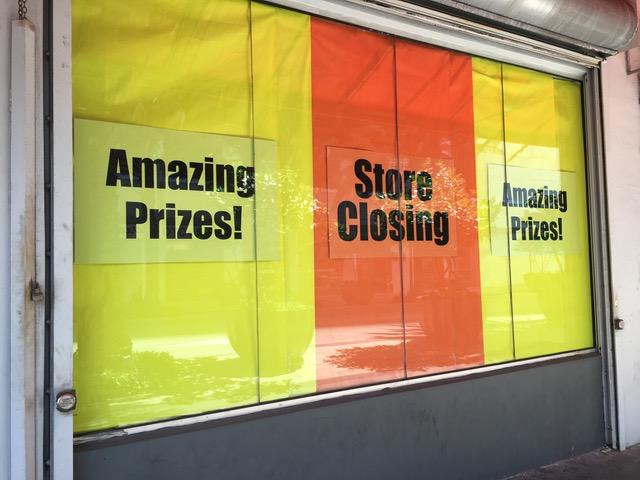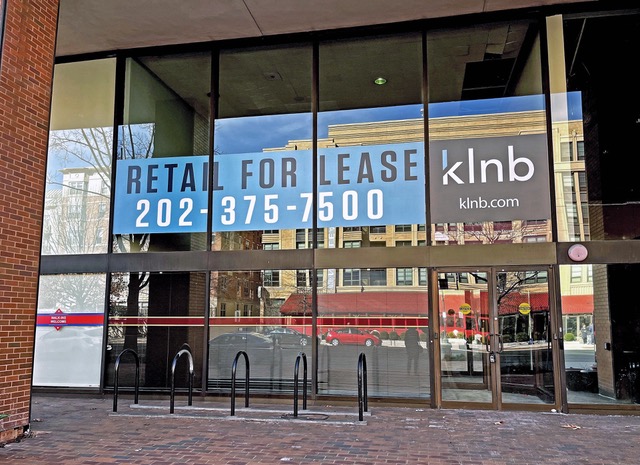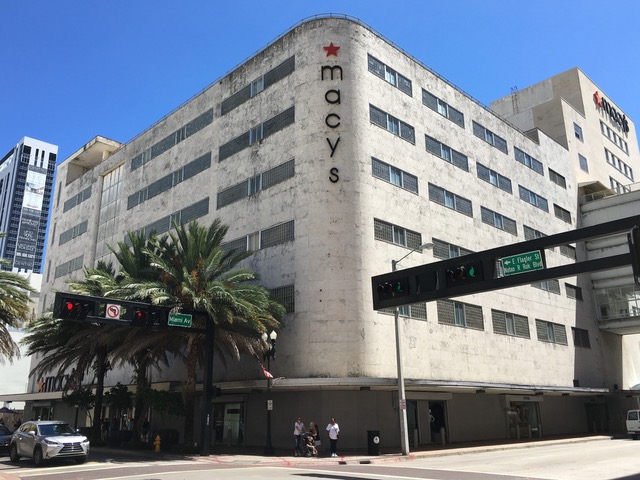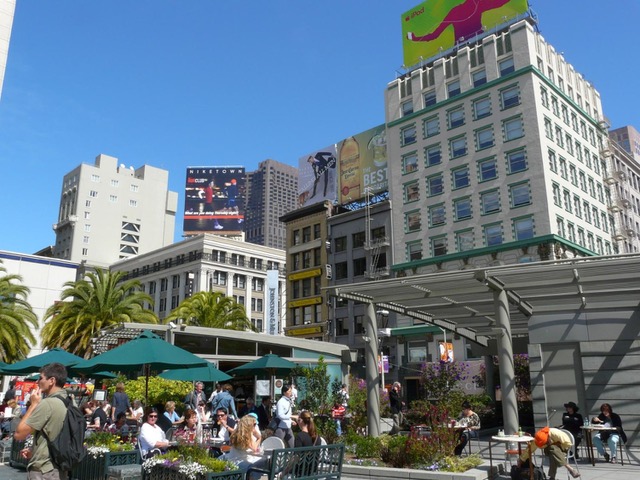A Placemaking Journal
Traditional retail is hanging by a thread in the US. What now for city leaders and planners?
Okay, I’ve seen enough vacant storefronts and closed stores. Is it time for city leaders and planners to adjust our expectations and planning precepts about traditional retail?
What’s happening to retail?
For example, my wife Sharon and I visited San Francisco last month. We stayed near Union Square, once that city’s hottest downtown shopping district. Our hotel was great, but much of the surrounding neighborhood gave off ghost-town vibes, with failed and failing retail all around us. As an example, we wanted to do some clothes shopping at Nordstrom, only to be told that the chain’s five-story flagship store in the city, previously a block or two away from our hotel, had closed about a year and a half ago. A CNN story by reporter Jordan Valinsky published at the time of the closing reported precipitously declining sales at the big retailer as well as scores of other retail closings in the district.

Similarly, we had to run an errand at a pharmacy, so we went to a nearby Walgreen’s. The store was open, but we were greeted by signs announcing that it would be permanently closing in about two weeks from when we visited. We did go to Bloomingdale’s, another five-story retailer in the district and the brand’s largest store outside of New York, but a story by Rachel Schier, published in February 2025 by CoStar News, reports that it will be closing “in a matter of months,” along with a nearby Macy’s. At the time of the CNN story, “more than 39” retailers had closed in the Union Square district since 2020; the number today is undoubtedly much higher than that.
Union Square has been hit particularly hard by the pandemic and by the loss of office workers to remote-work practices, but this trend is by no means limited to San Francisco. Visitors to Washington, DC, where I live, are greeted by vacant storefronts scattered throughout the city, especially but not limited to downtown. While some neighborhoods in the DC metro region are faring better than others, even relatively walkable and fairly affluent districts such as Van Ness and Friendship Heights have suffered from declining shopping traffic and sales.
Contributing force
I think a number of trends are contributing to declining urban retail, none bigger than a consumer shift to the convenience of online shopping and delivery. A second major factor is the rise of remote work practices and consequent decline in daily office workers who have traditionally supported businesses near their places of employment.
A third factor is rising crime rates in some urban neighborhoods. While crime rates vary widely among cities and among urban districts within cities, and some are currently (and happily) experiencing a decline in crime, nationally “most violent crimes are still higher now than in 2019, before the pandemic and social unrest of 2020,” according to a report authored by James Farrell and published last year in Forbes.
All of these trends were influenced in a big way by the pandemic, but at least online shopping and a significant amount of remote work appear to be here to stay. I think we may need to adjust our expectations regarding some bedrock axioms of urbanist (for lack of a better word) planning. For example, does it make sense to insist on first-floor retail in large commercial buildings to enhance walkability when there isn’t enough viable retail to fill the spaces? Does a formulaic approach to planning for retail districts (“It takes at least X number of dwelling units or offices within walking distance to sustain Main Street-style shopping areas”) work in the new era of online shopping?

I am not formally trained as a city planner, but I have been in and around the field for thirty years, and I am lucky to have worked with and learned from some of the best in the business. I’ve talked to some of them about this and, so far, I get the impression that my concerns are not – at least not yet – widely shared. The general response has been something approaching a shrug. Some simply don’t believe it’s happening or that Union Square and downtown Washington are special cases for various reasons, and not representative of the nation as a whole. Others point to bustling shopping areas in world-class international cities as evidence that it’s just not true. The more pragmatic among them urge that more housing in affected commercial areas would alleviate the problem.
On the last of those points, I strongly agree with building more housing in areas now dominated by office buildings. I think that would definitely help. So should back-to-the-office workplace policies. But, in my opinion, those things won’t help enough. I believe that there are more fundamental forces at work that will prevent traditional retail – at least with respect to the in-person buying and selling of merchandise – from a full recovery to the way things were, say, ten years ago.
Retail openings versus closings
For those who think this isn’t a big deal, consider two articles that appeared in The Washington Post in early 2025:
First, in an article posted February 5, Jaclyn Peiner writes that “brick-and-mortar retail had a tough year last year, and it’s only going to get harder in 2025,” citing projections by retail data firm Coresight Research. In particular, Coresight – a large firm that tracks all sorts of relevant data – predicts that some 15,000 stores are likely to close in 2025, about twice the number that closed last year.
While retail outlets both open and close all the time, even in more robust years, the number of closures next year is projected to be about three times the number of openings. Closures have exceeded openings in five of the last seven years, the unfavorable ratio of closings to openings actually worsening after the pandemic.
The effect of crime was noted in Peiner’s article, including the now-common practice of locking up even mundane products such as toothpaste and laundry detergent behind glass enclosures to deter theft. (I have myself witnessed significant shoplifting in broad daylight in Washington, as well as the presence of beefed-up security in many stores.)

Unfortunately, the locking of products for sale can deter purchases as well as thefts: As Mark Cohen, former director of retail studies at Columbia Business School, told Peiner, “who wants to go shopping for things in a store when there’s this added inconvenience of getting someone to unlock a shelf? It’s probably cheaper for them to order it online anyway and have it on their doorstep the next day.”
The article, which I recommend, also discusses the negative effects of larger economic factors such as a slew of major retail bankruptcies and inflation. Regarding the latter, Peiner notes that protectionist policies being implemented or threatened by the current federal political administration could well exacerbate inflation, with a further negative effect on retail’s prospects.
The decline of small businesses
Second, in a data-rich and amusingly written article posted January 31, 2025, Andrew Van Dam reports that all sorts of small businesses (defined as those with 100 or fewer employees), from gas stations to accounting firms, are losing ground compared to their much larger counterparts (think mom-and-pop retailers versus big chains such as Dollar General). While an amazing 98 percent of American businesses fall into the “small” category, the employment numbers tell a different story: 53 percent of Americans work for firms with 500 or more employees. And “businesses with fewer than 100 employees have steadily lost ground,” Van Dam writes, “while businesses with more than 10,000 employees have gained.”
There are both negative and positive impacts for urban retail in the details. Small clothing stores (along with gas stations, interestingly) have essentially “vanished” while, more encouragingly, “restaurants and microbreweries bucked the trend,” posting steep increases for small business employment in the last 20-30 years. “Despite all the anecdotes about how many restaurants fail in their first year, it turns out they’ve quietly conquered America,” writes Van Dam. “They have the biggest job growth of any industry since the late 1970s, well ahead of employment services and hospitals.”

According to government data from “the universally beloved” Quarterly Census of Employment and Wages (QCEW), only 13.6 percent of restaurants and closely related businesses established in 2023 failed to survive into 2024, the lowest failure rate of all 19 sectors measured in the QCEW. Van Dam posits that “small businesses in the restaurant industry may simply have been swept along in Americans’ long and increasingly torrid love affair with not cooking at home.”
I guess the data taken as a whole suggest that there are high risks associated with mixed-use planning for merchandise outlets, but significantly lower risks associated with planning for restaurants. My own observations would caution planners and developers to be careful even about the latter, though: downtown Washington is littered with failed restaurant sites that have traditionally catered to office workers.
What to do
So, if we can no longer rely on our longstanding assumptions concerning urban retail, what should those of us who care about cities do? Well, adding housing density to commercial areas could add a lot, putting more people – potential customers – within walking and easy driving distance of those establishments that remain viable such as restaurants and grocery stores; as another example, the hardware store in my neighborhood also enjoys a very brisk business. So would an enlivened generation of “third places” such as libraries, gyms, and small parks. In addition, city nature integrated into urban fabric brings multiple benefits to neighborhoods and almost always makes them more attractive to pedestrians. I suspect some readers of this article will be better than I am at coming up with good solutions; I recommend Fred Kent’s Social Life Project as a great place to start.
But I don’t think we will ever get back fully to the retail environment of previous decades, except perhaps in a few special places. The big counterforces – online shopping and a bigger degree of remote work practices – are here to stay. We’re in a different environment now, and new environments demand new ideas.









